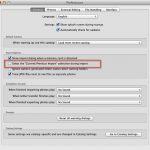Sara Collaton asked this question on Twitter yesterday of a number of Lightroom users. I could say experts, but it’s you guys and girls that get to decide who is or isn’t an expert! Anyway, to the topic at hand and my opinion on the matter.
Lightroom can have as many catalogs as you like, but there’s one very compelling reason to use just one catalog: Access to all of your photos. Of course finding what you’re looking for means that you need to at least name your files with something corresponding to the photo, and some generic keywords. This usually gets done on Import. Assuming you’ve done this, finding your images in Lightroom is a matter of searching text (which is where yesterdays Quick Find tip came from). You can find images in the OS with filenames and metadata too, but you’d not going to get the corrected version of the file (without it being a DNG or having XMP written). From a visual standpoint, you get to see these finished images after the search in Lightroom, which beats an OS search.
One catalog means a big catalog. In the past this would mean a huge Lightroom slowdown. Currently I’m running my catalog on a Firewire 800 drive, and I’m not finding any particular speed issues. There’s 185,000 photos in it. It stays around this, because I’m getting rid of more duds as time goes by.
What are good reasons for more than one Catalog? Well the work/play spilt is one. It may be beneficial to have separate Client and Personal catalogs. This works only if the 2 are completely separate, otherwise you could just use Collection Sets to manage them in one large catalog.
There is a 3rd workflow that uses many catalogs that can work too. I call the wedding/job method. Basically for each wedding or job, you create a folder for the job, with a catalog in the folder for that job. You do your selection and editing from that catalog, then using ‘Export as Catalog’, create a temporary catalog of the final images. Then switch to the your main catalog, and ‘Import from another Catalog’, bringing the selects into this. Delete the temporary catalog. Make sure the photos are imported using Add though. Why? Because you can right click the photo and ‘Show in Finder/Explorer’ to go back to the original folder and get to the job catalog quickly if you need to. With the selects in one big catalog, you can search your work easily.
Are there other workflows? Probably, but the key is to have some way to manage your best images in one place. One I can think of is the Catalog per Year system. As time passes, your memory of exactly what year a photo was taken can fade, so you could waste time searching 3 or 4 catalogs before you find the right one. There’s nothing to stop you adding a selects catalog, as with the wedding/job method above.
I will say that there is a bad catalog workflow, and that’s random catalogs with no cohesion. If you’re doing this, start a new catalog, and import the others into it, then uses Collections and Collection Sets to manage them.
Like I said at the beginning, this is just my opinion.










I am a big believer in the single catalog especially with the performance enhancements to Lightroom.
The “one place where I can find anything” seems to be the ideal. If I want to sort our personal or business files, I can do this in far less keystrokes or time than it would take to open a new catalog. My vote… make your life easy. Create one catalog.
-Gerard
http://www.mosaicarchive.com/blog
After 5 years with Lightroom I have concluded that 4 catalogues are working best for me.
1. Client Projects
2. Website
3. Portfolio
4. Personal
I am now working a cohesive workflow to intro-grate colour labeling RAW files, client selects, etc.
Any suggestions?
Twitter: @codycaissie
Facebook: http://www.facebook.com/codycaissiestudios
Website: http://www.codycaissie.com
Portfolio and website could be handled with collections inside a larger catalog. In terms of making information transfer between catalogs, XMP is the easiest way to do it. Flags are not stored in XMP as yet. Labels and ratings are, so do make use of them. Just make sure the labels match between catalogs. Save metadata to the file in one catalog (where you’ve applied them), and then read metadata from file in another.
I still have 3 catalogs after yesterday’s discussion but it’s really 2+.
I adopted a technique from Justin’s comment and moved my catalog files to my SSD drive instead of having them sit on my Drobo where the actual files are. Immediately saw an improvement on its speed.
I’m down to 2 large catalogs: those being Archives (basically any personal photos) and Clients.
Each of these catalogs are then organized by Folders per year, followed by folders per event.
Example: 2013 > 0522 Portrait Shoot
The 3rd catalog is just ongoing work that stays portable by having its catalog (and its files) on my laptop. Technically this is just a large temporary catalog until personal photos or client photos are finished and then they get exported into the two large Catalogs.
I then rely on OCD style keywords and smart collections to find and sort through my images. I still find this much faster than Lightroom’s actual ‘search’ option.
Thanks for a great discussion yesterday Sean, and enjoyed reading your post this morning.
No problem Sara! The post wouldn’t be there without you. Yep, the SSD should be tonnes faster. Even just the internal drive would be faster than the Drobo.
I use lots of catalogues. One for personal work (new one every year), but then each job gets it’s own catalogue. I shoot mostly weddings, so I have a directory for each wedding. Inside are sub directories for raws, processed jpegs, prints, album and the lightroom catalogue. That way, if I want to pull up images for a particular job, I can go in and double click it’s LRCat. And when I move the directory from my hard drive to archive storage, the catalogue moves with it
Hi Rory,
I have to ask, why every year for the personal catalog? Even if you’re shooting 20,000 images a year, it’d take a long time to get something that’s unwieldy. This means you can use publish collections to manage all your photos on Smugmug, Flickr, 500px, Facebook, etc. You have a visual representation of all the photos you have online. And can even handle the comments! On top of the searchability. Don’t get me wrong, I’m not poo pooing what you’re doing, I just think you can make it better for yourself.
And now the Clients. Let’s say a client needs a portfolio of the best photos from all your work with them. With the current setup, you need to open every job catalog one at a time, get images, export, move to the next catalog. You could create a catalog of those processed JPEG’s and keep them all together for your website, competition etc. Again, just a suggestion.
Hi Sean,
Thanks for the suggestions! In truth I probably don’t have a good reason for a new personal catalogue each year. I used to just have two catalogues – work and personal, but I do prefer now to use individual catalogues for each job. Maybe I won’t bother creating a new personal catalogue in 2014.
That’s a good idea of a single catalogue for the processed jpegs from my jobs. My work is 90% weddings, and I export all processed photos from each job as jpegs. I could create a jpeg only catalogue and import the jpegs from each job into this.
Thing is, when I archive the job folders off my hard drive, onto external storage, I’ll then have to point LR at the new location of the jpegs, which is a pain. Or am I missing something here?
As for how I view the processed jpegs right now – you’ll kill me for this! – I use Picasa!!
Rory
🙂
Whatever works Rory!
Jpegs are pretty small, so there’s nothing to stop you simply copying the files into a dedicated location. It’s just about access. You could also move the files within Lightroom instead, saving the bother of relinking. Even with 100 final files per wedding, 50 weddings a year, after 10 years that’s 50,000 files. That’s not big for Lightroom.